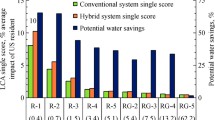Abstract
As an environmental friendly measure for surface runoff reduction, low impact development (LID) has been applied successfully in urban areas. However, due to high price of land and additional expense for LID construction in highly urbanized areas, the developers of real estate would not like to proceed LID exploitation. Floor area ratio (FAR) refers to “the ratio of a building’s total floor area to the size of the piece of land upon which it is built.” Increasing FAR indicates that the developers can construct higher buildings and earn more money. By means of awarding FAR, the developers may be willing to practice LID construction. In this study, a new residential district is selected as a case study to analyze the tradeoff between the runoff reduction goal achieving by LID practices and the incentive of awarding FAR to promote LID construction. The System for Urban Stormwater Treatment and Analysis IntegratioN (SUSTAIN) model is applied to simulate the runoff reduction under various LID designs and then derive the Pareto-optimal solutions to achieve urban runoff reduction goals based on cost efficiency. The results indicates that the maximum surface runoff reduction is 20.5%. Under the extremity scenarios, the government has options to award FAR of 0.028, 0.038 and 0.047 and the net benefits developers gain are 0 CNY, one million CNYand two million CNY, respectively. The results provide a LID construction guideline related to awarding FAR, which supports incentive policy making for promoting LID practices in the highly urbanized areas.

Similar content being viewed by others
References
Hu M, Sayama T, Zhang X, Tanaka K, Takara K, Yang H. Evaluation of low impact development approach for mitigating flood inundation at a watershed scale in China. Journal of Environmental Management, 2017, 193: 430–438
Maniquiz-Redillas M C, Kim L H. Evaluation of the capability of low-impact development practices for the removal of heavy metal from urban stormwater runoff. Environmental Technology, 2016, 37 (18): 2265–2272
Olorunkiya J, Fassman E, Wilkinson S. Risk: A fundamental barrier to the implementation of low impact design infrastructure for urban stormwater control. Journal of Sustainable Development, 2012, 5 (9): 27–41
Kim J H, Kim H Y, Demarie F. Facilitators and barriers of applying low impact development practices in urban development. Water Resources Management, http://doi.org/10.1007/s11269-017-1707-5
Assad N. Locating barriers to and opportunities for implementing low impact development within a governance and policy framework in Southern Ontario. Thesis for the Master Degree. Guelph: The University of Guelph, 2012
Lu Z, Noonan D, Crittenden J, Jeong H, Wang D. Use of impact fees to incentivize low-impact development and promote compact growth. Environmental Science & Technology, 2013, 47(19): 10744–10752
Atchison D, Gill P, Clancy M, Merrill A. Birch Bay Wate7rshed Action Plan: Linking Low Impact Development with Improved Critical Areas Management. Proceedings of the Water Environment Federation, 2012: 277–288
Olorunkiya J O, Wilkinson S, Fassman E A, Stuart D. Eliciting Stakeholders’ preferences for low-impact design incentives: Conjoint analysis approach. Journal of Legal Affairs & Dispute Resolution in Engineering & Construction, 2013, 5(4): 180–190
Jung S J, Yoon S H. Analysis on the influence of building coverage ratio and floor area ratio on sunlight environment and outdoor thermal environment in flat-type apartment houses. Journal of the Architectural Institute of Korea Planning & Design, 2015, 31(5): 69–76
Tsai Y H. Location-demand-based residential floor area ratio distribution method. Urban Studies (Edinburgh, Scotland), 2014, 51(12): 2685–2702
Matsuhashi K, Shiraki H, Ashina S, Ariga T. A Proposal of the floorto-area ratio bonus for the zero carbon urban redevelopment utilizing renewable energy. Journal of Japan Society of Civil Engineers Ser G, 2014, 70(6): 81–86
Tsunematsu N, Yokoyama H, Honjo T, Ichihashi A, Ando H, Shigyo N. Relationship between land use variations and spatiotemporal changes in amounts of thermal infrared energy emitted from urban surfaces in downtown Tokyo on hot summer days. Urban Climate, 2016, 17: 67–79
Gao J, Wang R, Huang J, Liu M. Application of BMP to urban runoff control using SUSTAIN model: Case study in an industrial area. Ecological Modelling, 2015, 318(1): 177–183
Lee J G, Selvakumar A, Alvi K, Riverson J, Zhen J X, Shoemaker L, Lai F. A watershed-scale design optimization model for stormwater best management practices. Environmental Modelling & Software, 2012, 37(37): 6–18
Jia H, Yao H, Tang Y, Yu S L, Field R, Tafuri A N. LID-BMPs planning for urban runoff control and the case study in China. Journal of Environmental Management, 2015, 149: 65–76
Chen C F, Sheng M Y, Chang C L, Kang S F, Lin J Y. Application of the SUSTAIN Model to a watershed-scale case for water quality management. Water (Basel), 2014, 6(12): 3575–3589
Qin H P, Li Z X, Fu G. The effects of low impact development on urban flooding under different rainfall characteristics. Journal of Environmental Management, 2013, 129(18): 577–585
Rosa D J, Clausen J C, Dietz M E. Calibration and verification of SWMM for Low Impact Development. Jawra Journal of the American Water Resources Association, 2015, 51(3): 746–757
Palla A, Gnecco I. Hydrologic modeling of Low Impact Development systems at the urban catchment scale. Journal of Hydrology (Amsterdam), 2015, 528: 361–368
Nash J E, Sutcliffe J V. River flow forecasting through conceptual models part I-A discussion of principles. Journal of Hydrology (Amsterdam), 1970, 10(3): 282–290
Jia H, Lu Y, Yu S L, Chen Y R. Planning of LID–BMPs for urban runoff control: The case of Beijing Olympic Village. Separation and Purification Technology, 2012, 84(2): 112–119
Tetra Tech, Inc.SUSTAIN Step-by-Step Application Guide Version 1.2. US: EPA, 2012
Acknowledgements
This research was supported by the National Water Pollution Control and Management Technology Major Projects (No. 2013ZX07501005) and Project of Technology & Innovation Com-mission of Shenzhen Municipality (No. ZDSYS20140509094114169).
Author information
Authors and Affiliations
Corresponding author
Rights and permissions
About this article
Cite this article
Cheng, M., Qin, H., He, K. et al. Can floor-area-ratio incentive promote low impact development in a highly urbanized area?—A case study in Changzhou City, China. Front. Environ. Sci. Eng. 12, 8 (2018). https://doi.org/10.1007/s11783-017-1002-y
Received:
Revised:
Accepted:
Published:
DOI: https://doi.org/10.1007/s11783-017-1002-y




